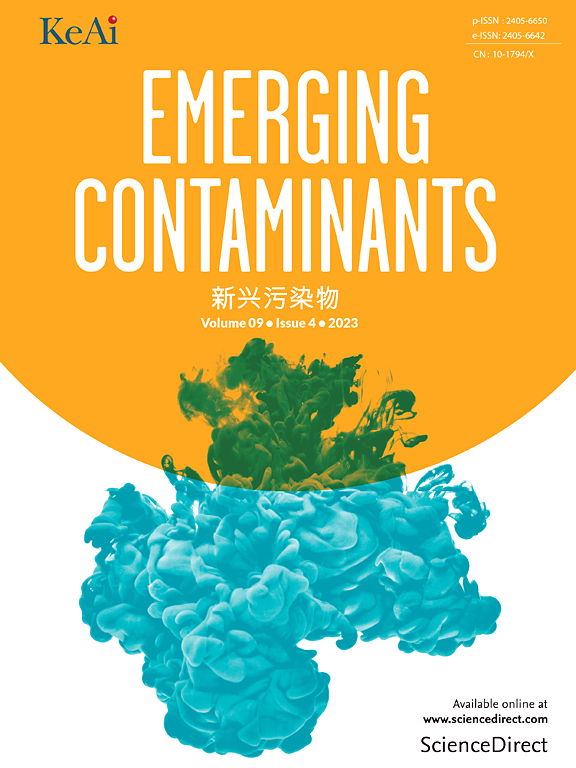在太阳能驱动模拟下,活性炭负载nife层状双氢氧化物(NiFe-LDH/C)高效光催化降解美托洛尔
IF 6.9
2区 环境科学与生态学
Q1 ENVIRONMENTAL SCIENCES
引用次数: 0
摘要
高效光催化降解废水中的药物对环境保护具有重要意义。本文研究了nfe - ldh /C在紫外光条件下光催化降解β-阻滞剂(特别是美托洛尔)的合成和表征。该研究旨在探索NiFe-LDH/C作为降解美托洛尔催化剂的潜力,美托洛尔是一种常用的药物化合物,用于治疗高血压和胸痛等慢性疾病,在废水中经常检测到。NiFe-LDH/C材料的选择主要考虑到材料的光催化活性、生成活性氧和增强电荷分离的能力以及在太阳光下的稳定性。采用活性炭作为载体,增加LDH颗粒的表面积,改善分散性,从而提高整体光催化效率。结果表明,nfe - ldh /C在紫外和光照条件下对美托洛尔的降解均表现出优异的光催化活性,降解效率均在89%以上。此外,NiFe-LDH/C催化剂的表征表明其稳定性和可回收性,使其成为光催化降解废水中药物化合物的有希望的候选物。表征结果表明,nfe - ldh /C具有较高的结晶度和清晰的层状结构。光催化实验证明了NiFe-LDH/C对美托洛尔的降解效果,并利用超高效液相色谱-质谱(UPLC-MS)对水中美托洛尔的降解产物进行了分析。本文章由计算机程序翻译,如有差异,请以英文原文为准。
Efficient photocatalytic degradation of metoprolol using activated carbon supported NiFe-layered double hydroxides (NiFe-LDH/C) under solar-driven simulation
The efficient photocatalytic degradation of pharmaceuticals in wastewater is critically important for environmental protection. The synthesis and characterization of NiFe-LDH/C for the photocatalytic degradation of selected β-blockers, specifically metoprolol, under UV light conditions were investigated in this study. The study aimed to explore the potential of NiFe-LDH/C as a catalyst for the degradation of metoprolol, a commonly used pharmaceutical compound in the treatment of chronic diseases such as high blood pressure and chest pains, which is frequently detected in wastewater. The selection of NiFe-LDH/C was driven by the need for materials with high photocatalytic activity, the ability to generate reactive oxygen species and enhance charge separation, and stability under solar light. Activated carbon was employed as a support to increase the surface area and improve the dispersion of the LDH particles, thereby enhancing overall photocatalytic efficiency. The results showed that NiFe-LDH/C exhibited excellent photocatalytic activity in degrading metoprolol under both UV and sunlight-mediated conditions, with degradation efficiencies of over 89 %. Furthermore, the characterization of the NiFe-LDH/C catalyst revealed its stability and recyclability, making it a promising candidate for the efficient removal of pharmaceutical compounds from wastewater through photocatalytic degradation. The characterization results showed that the NiFe-LDH/C exhibited a high degree of crystallinity and a well-defined layered structure. The photocatalytic experiments demonstrated that the NiFe-LDH/C was effective in degrading metoprolol and ultra-performance liquid chromatography-mass spectrometry (UPLC-MS) was used to elucidate the degradation products of metoprolol in water.
求助全文
通过发布文献求助,成功后即可免费获取论文全文。
去求助
来源期刊

Emerging Contaminants
Medicine-Public Health, Environmental and Occupational Health
CiteScore
10.00
自引率
6.70%
发文量
35
审稿时长
44 days
期刊介绍:
Emerging Contaminants is an outlet for world-leading research addressing problems associated with environmental contamination caused by emerging contaminants and their solutions. Emerging contaminants are defined as chemicals that are not currently (or have been only recently) regulated and about which there exist concerns regarding their impact on human or ecological health. Examples of emerging contaminants include disinfection by-products, pharmaceutical and personal care products, persistent organic chemicals, and mercury etc. as well as their degradation products. We encourage papers addressing science that facilitates greater understanding of the nature, extent, and impacts of the presence of emerging contaminants in the environment; technology that exploits original principles to reduce and control their environmental presence; as well as the development, implementation and efficacy of national and international policies to protect human health and the environment from emerging contaminants.
 求助内容:
求助内容: 应助结果提醒方式:
应助结果提醒方式:


